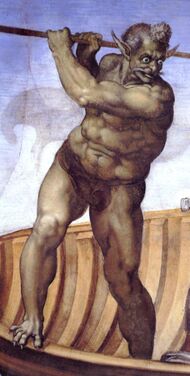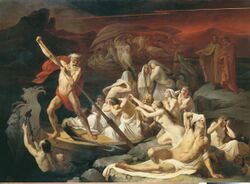Religion:Charon
In Greek mythology, Charon or Kharon (/ˈkɛərɒn, -ən/; Ancient Greek:) is a psychopomp, the ferryman of Hades, the Greek underworld. He carries the souls of those who have been given funeral rites across the rivers Acheron and Styx, which separate the worlds of the living and the dead.[1] Archaeology confirms that, in some burials, low-value coins were placed in, on, or near the mouth of the deceased, or next to the cremation urn containing their ashes. This has been taken to confirm that at least some aspects of Charon's mytheme are reflected in some Greek and Roman funeral practices, or else the coins function as a viaticum for the soul's journey.[1][2] In Virgil's epic poem, Aeneid, the dead who could not pay the fee, and those who had received no funeral rites, had to wander the near shores of the Styx for one hundred years before they were allowed to cross the river.[3]
Some mortals, heroes, and demigods were said to have descended to the underworld and returned from it as living beings. This journey is known as catabasis, and those who undergo it may acquire partial or full immortality, either through persuasion or payment of another, more exceptional fee. To pay for his entry to Hades as a living mortal, Virgil's Aeneas gives Charon the Golden Bough.[4]
Name origins
The name Charon is most often explained as a proper noun from χάρων (charon), a poetic form of χαρωπός (charopós) 'of keen gaze', referring either to fierce, flashing, or feverish eyes, or to eyes of a bluish-gray color. The word may be a euphemism for death.[5] Flashing eyes may indicate the anger or irascibility of Charon as he is often characterized in literature, but the etymology is not certain. The ancient historian Diodorus Siculus thought that the ferryman and his name had been imported from Egypt.[6] Charon is first attested in the now fragmentary Greek epic poem Minyas, which includes a description of a descent to the underworld and possibly dates back to the 6th century BC.[7]
Appearance and demeanor
Charon is depicted in the art of ancient Greece. Attic funerary vases of the 5th and 4th centuries BC are often decorated with scenes of the dead boarding Charon's boat. On the earlier such vases, he looks like a rough, unkempt Athenian seaman dressed in reddish-brown, holding his ferryman's pole in his right hand and using his left hand to receive the deceased. Hermes sometimes stands by in his role as psychopomp. On later vases, Charon is given a more "kindly and refined" demeanor.[8]
In the 1st century BC, the Roman poet Virgil describes Charon, manning his rust-colored skiff, in the course of Aeneas's descent to the underworld (Aeneid, Book 6), after the Cumaean Sibyl has directed the hero to the golden bough that will allow him to return to the world of the living:
There Charon stands, who rules the dreary coast –
A sordid god: down from his hairy chin
A length of beard descends, uncombed, unclean;
His eyes, like hollow furnaces on fire;
A girdle, foul with grease, binds his obscene attire.[9]
Other Latin authors also describe Charon, among them Seneca in his tragedy Hercules Furens, where Charon is described in verses 762–777 as an old man clad in foul garb, with haggard cheeks and an unkempt beard, a fierce ferryman who guides his craft with a long pole. When the boatman tells Heracles to halt, the Greek hero uses his strength to gain passage, overpowering Charon with the boatman's own pole.[10]
In the second century, Lucian employed Charon as a figure in his Dialogues of the Dead, most notably in Parts 4 and 10 ("Hermes and Charon" and "Charon and Hermes").[11]
In the 14th century, Dante Alighieri described Charon in his Divine Comedy, drawing from Virgil's depiction in Aeneid 6. Charon is the first named mythological character Dante meets in the underworld, in Canto III of the Inferno. Dante depicts him as having eyes of fire. Elsewhere, Charon appears as a mean-spirited and gaunt old man or as a winged demon wielding a double hammer, although Michelangelo's interpretation, influenced by Dante's depiction in the Inferno, shows him with an oar over his shoulder, ready to beat those who delay (“batte col remo qualunque s'adagia”, Inferno 3, verse 111).[12] In modern times, he is commonly depicted as a living skeleton in a cowl, much like the Grim Reaper. The French artist, Gustave Dore, depicted Charon in two of his illustrations for Dante's Divine Comedy. The Flemish painter, Joachim Patinir, depicted Charon in his Crossing the River Styx. And the Spanish painter, Jose Benlliure y Gil, portrayed Charon in his La Barca de Caronte.
The Acheron and the Styx
| Greek underworld |
|---|
| Residents |
|
| Geography |
|
| Famous Tartarus inmates |
|
| Visitors |
|
Most accounts, including Pausanias (10.28) and later Dante's Inferno (3.78), associate Charon with the swamps of the river Acheron. Ancient Greek literary sources – such as Pindar, Aeschylus, Euripides, Plato, and Callimachus – also place Charon on the Acheron. Roman poets, including Propertius, Ovid, and Statius, name the river as the Styx, perhaps following the geography of Virgil's underworld in the Aeneid, where Charon is associated with both rivers.[13]
In astronomy
Charon, the largest moon of the dwarf planet Pluto, is named after him.[14]
In paleontology
The hadrosaurid Charonosaurus is named in Charon's honor because it was found along the banks of the Amur River in the Far East.[15]
Modern usage as Haros
Haros or Charos (Greek: Χάρος) is the modern Greek equivalent of Charon. It is used in common phrases such as "from the teeth of Haros" (Greek: από του Χάρου τα δόντια) meaning to come close to death or "you will be eaten (i.e. taken) by Haros".
During the Korean War, the Greek Expeditionary Force defended an outpost called Outpost Harry.[16] The Greek soldiers referred to it as "Outpost Haros".[17]
See also
- Charun – an Etruscan counterpart to Charon
- Coins for the dead
- Isle of the Dead – a painting by Swiss Symbolist artist Arnold Böcklin
- Manannán mac Lir – Ferryman from Irish mythology
- Manunggul Jar – Early depiction similar figure on burial jar from Tabon Caves on Palawan
- Phlegyas – another god often associated with ferrying the dead
- Urshanabi – Ferryman from Mesopotamian mythology
References
- ↑ 1.0 1.1 "Charon | Myth & Symbols" (in en). https://www.britannica.com/topic/Charon-Greek-mythology.
- ↑ Coins were not placed on the eyes; all literary sources specify the mouth. Callimachus, Hecale fragment 278 in R. Pfeiffer's text Callimachus (Oxford UP, 1949), vol.2, p. 262; now ordered as fragment 99 by A.S.D. Hollis, in his edition, Callimachus: Hecale (Clarendon Press, Oxford 1990), pp. 284f., from the Suidas, English translation online, specifying the mouth, also Etymologicum Graecum ("Danakes"). See also Smith's Dictionary of Greek and Roman Biography and Mythology, entry on "Charon" online for placement in the mouth, though archaeology disproves Smith's statement that every corpse was given a coin; see article on Charon's obol.
- ↑ Virgil, Aeneid 6, 324–330.
- ↑ They include characters of Greco-Roman mythology such as Aeneas, Dionysus, Heracles, Odysseus, Orpheus, Pirithous, and Psyche.
- ↑ Liddell and Scott, A Greek-English Lexicon (Oxford: Clarendon Press 1843, 1985 printing), entries on χαροπός and χάρων, pp. 1980–1981; Brill's New Pauly (Leiden and Boston 2003), vol. 3, entry on “Charon,” pp. 202–203.
- ↑ Christiane Sourvinou-Inwood, "Reading" Greek Death (Oxford University Press, 1996), p. 359 online and p. 390 online.
- ↑ Christiane Sourvinou-Inwood, Charon (1), Oxford Classical Dictionary, 1995, Published online: 07 March 2016 [1] (accessed 28 September 2020)
- ↑ Grinsell, L. V. (1957). "The Ferryman and His Fee: A Study in Ethnology, Archaeology, and Tradition". Folklore 68 (1): 257–269 [p. 261]. doi:10.1080/0015587x.1957.9717576.
- ↑ Virgil, Aeneid 6.298–301, as translated by John Dryden.
- ↑ See Ronnie H. Terpening, Charon and the Crossing: Ancient, Medieval, and Renaissance Transformations of a Myth (Lewisburg: Bucknell University Press, 1985 and London and Toronto: Associated University Presses, 1985), pp. 97–98.
- ↑ For an analysis of these dialogues, ss Terpening, pp. 107–116.
- ↑ For an analysis of Dante's depiction of Charon and other appearances in literature from antiquity through the 17th century in Italy, see Terpening, Charon and the Crossing.
- ↑ See Kharon at theoi.com for collected source passages with work and line annotations, as well as images from vase paintings.
- ↑ Dennis, Overbye (2013-07-02). "Two of Pluto's Moons Get Names From Greek Mythology's Underworld". The New York Times. https://www.nytimes.com/2013/07/03/science/space/two-of-plutos-moons-get-names-from-greek-mythologys-underworld.html.
- ↑ Godefroit, Pascal; Shuqin Zan; Liyong Jin (2000). "Charonosaurus jiayinensis n. g., n. sp., a lambeosaurine dinosaur from the Late Maastrichtian of northeastern China". Comptes Rendus de l'Académie des Sciences, Série IIA. 330: 875–882. Bibcode:2000CRASE.330..875G. doi:10.1016/S1251-8050(00)00214-7.
- ↑ War History Compilation Committee (1977), The History of the United Nations Forces in the Korean War, 6, Seoul: Republic of Korea Ministry of National Defense, OCLC 769331231
- ↑ "The soldiers of the Greek Expeditionary Forces called it Outpost "Haros" the Greek name for Death. It was classic wartime humor, a dark pun borne of a hopeless mission". outpostharry.org. http://www.outpostharry.org/documentary.shtml.
Sources
- Bzinkowski, Michal (2017). Masks of Charos in Modern Greek Demotic Songs: Sources, Representations, and Context. Krakow: Jagiellonian University Press. ISBN:978-83-233-4330-1.
- Smith, William (1873). "Charon". Dictionary of Greek and Roman Biography and Mythology. London.
External links
- The Theoi Project, "KHARON"
- Images of Charon in the Warburg Institute Iconographic Database





